Understand the meaning of the Order’s emblems, Jewel of Office, and the role as a council fraternal leader
Emblems
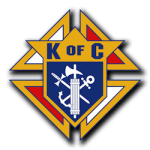
Emblem of Order
The emblem of the Order dates from the second Supreme Council meeting, held May 12, 1883. It was designed by then-Supreme Knight James T. Mullen.
The emblem is composed of a shield mounted upon the Formée Cross. The shield is associated with medieval knights. The Formée Cross is a traditional artistic design of the Cross of Christ and represents the Catholic spirit of the Order.
Mounted on the shield is a vertically standing fasces with an anchor and short sword crossed behind it. The fasces dates from the Roman Empire and is symbolic of authority, which must exist in any tightly bonded and efficiently operating organization. The anchor is the mariner’s symbol, symbolic of Columbus, patron of the Order. The short sword was the weapon of the knight when engaged upon errands of mercy. Together with the shield and the letters K of C, these symbols express Catholic knighthood in organized, merciful action.
The colors of red, white and blue in the background of the shield and the foreground of the Formée Cross are colors that represent noble aspects of the Order. Red is symbolic of stout-hearted courage, of pulsing activity and a full measure of devotion. Blue is symbolic of hope, of calm tranquility under God and of confidence in the protection of one’s country. White is symbolic of nobility of purpose, of purity of aim and of crucible-tried ideals to be carried out.
There are also ecclesiastical symbolism for the colors red, white and blue. Red is symbolic of Christ’s redemptive blood, shed upon Calvary, and of the martyrs’ blood, shed in defense of faith. Red is the symbol of faith, belief in Christ, redemption and knowledge of the love of Jesus Christ. White is symbolic of the Eucharistic host, pledge of God’s Eucharistic presence among men, the infinite love God has for man and the overwhelming affection which
God has for each individual. White is symbolic of Christ-like charity. Blue is symbolic of Our Lady’s mantle, in which she wrapped her beloved Son, through whom came salvation to a sinful world. Blue is the symbol of hope.
Council Officers
Unless otherwise noted, the following positions are elected annually by your council’s membership.
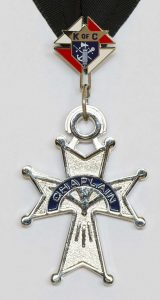 Chaplain
Chaplain
- A priest chosen annually by the grand knight, deputy grand knight and board of trustees
- Acts as spiritual advisor to the brother Knights and families of a council
- Provides his message to members at the beginning of the meeting as outlined in the Method of Conducting Council Meetings (#10318) or whenever it best suits his schedule
- The chaplain should attend meetings of the council — including officers’ meetings — whenever his schedule allows, as his advice is frequently needed
Additional information on the role of the chaplain is contained in the Chaplain’s Handbook (#945).
The jewel of the council chaplain is a silver Isabella Cross, overlaid with a descending dove, suspended from a ribbon of black. This style of Cross is associated with Queen Isabel of Spain, promoter of the voyage of Christopher Columbus. A Cross is a symbol of hope through atonement, reminding Christians of God’s love in sacrificing his own son for humanity. The dove, emblem of the Holy Spirit, represents the gift of the Word of God. The ribbon of black represents strength and authority.
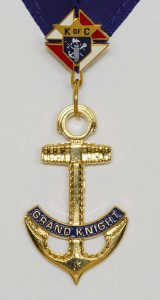 Grand Knight
Grand Knight
- Presides over all council meetings
- Appoints program and membership directors
- Appoints committees as needed
- Countersigns orders for payment and checks
- Ensures the submission of all paperwork required by the Supreme and State Councils
- Maintains working relationships with the council’s chaplain, district deputy, field agent and general agent; as well as with other local service organizations (e.g. Habitat for Humanity, food pantries/soup kitchens)
- Has a working knowledge of the Knights of Columbus website, Officers Online and Member Management
- Responsible for council’s Admission Degree Team and the scheduling of frequent Admission (First Degree) Ceremonials
Additional information to assist the grand knight in the performance of his duties can be found in the Grand Knight’s Guide (#5085), the Knights of Columbus Leadership Resources (#5093) and the Method of Conducting Council Meetings (#10318). Further details are also available on the Knights of Columbus Fraternal Training Portal.
The jewel of office for the grand knight is an anchor suspended from a ribbon of purple. The anchor is symbolic of Christopher Columbus, the mariner, who is the patron of our Order. The anchor, for centuries, was also a variant form of the Cross and symbolizes Christian hope. The ribbon of purple symbolizes authority and justice.
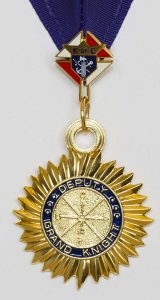 Deputy Grand Knight
Deputy Grand Knight
- Assists the grand knight with operation of the council
- Presides at council meetings in the absence of the grand knight
- Is recommended to serve on the council’s retention committee
- Has a working knowledge of the Knights of Columbus website, Officers Online and Member Management
- Performs other such duties as the grand knight may direct
The deputy grand knight should be familiar with the
Method of Conducting Council Meetings (#10318).
The deputy grand knight’s jewel of office is a compass suspended from a ribbon of purple. A compass is the constant guide and companion to the mariner, and was an invaluable tool used by Columbus to guide him to the shores of the New World. The Knights of Columbus “compass of virtue” has 32 flame-like rays; each ray represents a virtue that people can aspire to emulate in their daily lives. The ribbon of purple signifies authority and justice.
 Chancellor
Chancellor
- Assists the grand knight and deputy grand knight with their duties, as assigned
- Is entrusted with strengthening the members’ interest in council activities
- Is recommended to serve as the chairman of the Admission Committee
- Performs other such duties as the grand knight may direct
It is recommend for the chancellor to be familiar with the Order’s qualifications for membership, the Membership Document (#100) and the Member/Prospect Interest Survey (#1842).
The jewel of the chancellor is the Isabella Cross, overlaid with a skull and crossbones, suspended from a ribbon of black and white. The Cross represents atonement and the love of God, who sent to us his only begotten Son. The skull and crossbones are symbolic of man’s mortality and the vigilance required to remain faithful at all times.
Through the unity of the council, brothers help each other remain steadfast in their faith. The ribbon of black and white signifies strength and goodness.
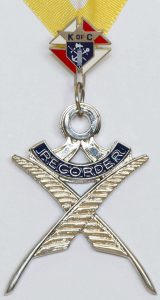 Recorder
Recorder
- Responsible for keeping and maintaining a true and permanent record of all actions of the council, using a Recorder’s Minute Book (#1403)
- Maintains all correspondence of the council
- Reads the bills entered into the minutes for discussion
- Performs such other duties as the grand knight may direct
The jewel of the recorder is crossed quills suspended from a ribbon of yellow and white. The quills represent writing,
knowledge and communication, and are also symbolic of the recorder’s duty to write and preserve letters and documents (records). The ribbon of yellow and white represents intellect and goodness.
 Financial Secretary
Financial Secretary
- Is appointed by the supreme knight for a three-year term upon the grand knight and trustees’ recommendation
- Must complete and submit the Application for Appointment as Financial Secretary (#FS101) to the Supreme Council
- Collects dues from members through the timely sending of billing notices and initiates retention measures by providing a list of delinquent members to the grand knight (to prevent members from being suspended for nonpayment of dues)
- Ensures that the council’s membership records, including email addresses, are kept updated and that new members sign the constitutional roll
- Receives honorary and honorary life membership cards from the Supreme Council and provides them to the grand knight for distribution
- Receives the “Surge . . . with Service” materials each fraternal year from the Supreme Council and distributes accordingly
- Files various reports and membership/insurance transactions with the Supreme Council
- Has a working knowledge of the Knights of Columbus website, Officers Online and the Member Management/Member Billing Applications
- Responsible for completing and submitting a Form W-9 for the council (U.S. only)
- Keeps the seal of the council and affixes it to membership cards, resolutions and other official documents
- Performs such other duties as the grand knight may direct
Additional information on the duties and responsibilities of the financial secretary can be found in the Knights of Columbus Leadership Resources Book (#5093).
The jewel of the financial secretary is a key and quill surrounded by a laurel wreath, suspended from a ribbon of yellow and white.
The key is associated with guardianship, while the quill is the symbol of a “scribe” — one who writes and keeps track of various letters and documents. The laurel wreath acknowledges the special service of the financial secretary to his council. The ribbon of yellow and white represents intellect and goodness.
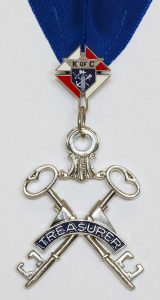 Treasurer
Treasurer
- Handles council funds
- Receives money from the financial secretary and deposits it in the proper council accounts
- Maintains all of the council’s checking and savings accounts
- Is responsible for paying all council expenses, including assessments from the Supreme Council
- Performs other such duties as the grand knight may direct
The jewel of the treasurer is crossed keys suspended from a ribbon of blue. The keys symbolize the guardianship of the funds of the council. The ribbon of blue represents truth and loyalty.
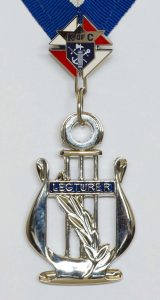 Lecturer
Lecturer
- Is appointed annually by the grand knight
- Is responsible for providing suitable educational and entertainment programs under the “Good of the Order” section of council meetings
- Stays abreast of developments within the council’s charitable, membership and social programs
- Performs other such duties as the grand knight may direct
The lecturer jewel is a lyre and laurel branch suspended from a ribbon of blue and white. The lyre with the laurel branch are traditionally symbolic of music, literature and the arts. The ribbon of blue and white represents purity and faithfulness.
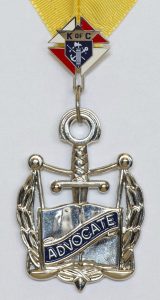 Advocate
Advocate
- Acts as parliamentarian for the council
- Has a working knowledge of Method of Conducting Council Meetings (#10318)
- Knows the council’s bylaws and the Order’s Charter, Constitution and Laws (#30)
- Has access to Officers Online and Officers Desk Reference
- Seeks legal assistance from the state advocate as needed
- Performs other such duties as the grand knight may direct
The jewel of the advocate is a scroll and sword, surrounded by a laurel wreath, suspended from a ribbon of gold. The opened scroll represents legal literature and signifies the power of knowledge, and the sword represents its defense and enforcement. Thus, it is the advocate’s role to not only know the laws of the council, but to also follow them strictly. The ribbon of gold represents faith, constancy and wisdom.
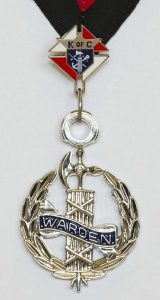 Warden
Warden
- Supervises and maintains all council property
- Arranges the council chambers for meetings and degree exemplifications
- Oversees inside and outside guards
- Performs other such duties as the grand knight may direct
The jewel of office of the warden is an axe bound with a fasces, surrounded by a laurel wreath, suspended from a ribbon of red and black. The fasces was a traditional symbol carried by the protectors or guards of the Roman magistrates as a symbol of authority and protection. The ribbon of red and black represents strength and fidelity to duty.
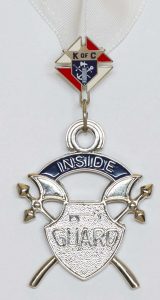
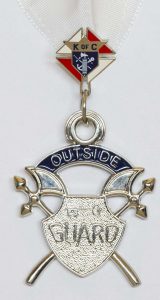 Inside / Outside Guards
Inside / Outside Guards
- Attend the doors of the council chamber, checking for current membership cards and allowing entrance
- Perform other such duties as the grand knight may direct
The jewel of the council guards is crossed axes and a shield, marked with a key, suspended from a ribbon of white. The shield and axe are symbolic of protection, and key is emblematic of guardianship. The ribbon of white represents purity and diligence to duty.
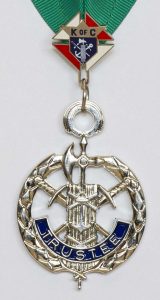 Board of Trustees
Board of Trustees
- Consists of the grand knight and three other members, who are elected by the council’s membership for terms of three years, two years and one year
- At each regular election, the position of each trustee will be voted upon, with the current three- and two-year trustee potentially moving on to become the two- and one-year trustee, respectively
- Supervises all financial procedures of the council and conducts the semiannual audits
- Ensures that proper protocol and procedures are followed by the council for the payment of monies — however, cannot override the vote of the council’s membership
The trustee jewel of office is composed of an ax and fasces overlaid with an anchor, positioned over crossed swords, surrounded with a laurel wreath and suspended from a ribbon of green. The fasces is an ax bound with rods. The swords symbolize justice and
honor. The laurel wreath symbolizes special service. The trustees are generally past grand knights, and this is the reason for the anchor over the fasces. The ribbon of green symbolizes loyalty in love.
Directors
Program Director
- Is appointed annually by the grand knight
- Collaborates with the grand knight and council leaders in setting the calendar of council programs for the year
- Assists and oversees each service program director as they implement the council’s programs and activities. Service program directors represent the “Surge . . . with Service” program categories of:
- Church
- Community
- Council
- Culture of Life
- Family
- Youth
- Keeps accurate records of council programs for the Annual Survey of Fraternal Activity (#1728) and the Columbian Award Application (#SP-7)
- Keeps council’s public relations chairman informed of all programs and activities for promotion to the parish and local media
Activities Directors
- Directors of each service program area (Church, Community, Council, Culture of Life, Family and Youth) are appointed annually by the grand knight on the recommendation of the program director
- Are responsible for recommending and overseeing the various activities chairmen, which are appointed by the grand knight
- Keep accurate records of their related programs for reporting on the Annual Survey of Fraternal Activity (#1728) and the Columbia Award Application (#SP-7)
- The youth activities director must also pass a background check and adhere to all policies and procedures under the Knights of Columbus Safe Environment Program. Additional information on this program is available on the Knights of Columbus website at kofc.org/safe
Membership Director
- Appointed annually by the grand knight
- Collaborates with the grand knight and council leaders on council membership goals for the year
- Partners with the chaplain, field agent and district deputy to ensure that every eligible Catholic is invited to join your council
- Responsible for recommending and overseeing the Admission Committee, retention committee, and insurance promotion committee chairmen
- Plans and coordinates the council’s schedule of recruitment programs